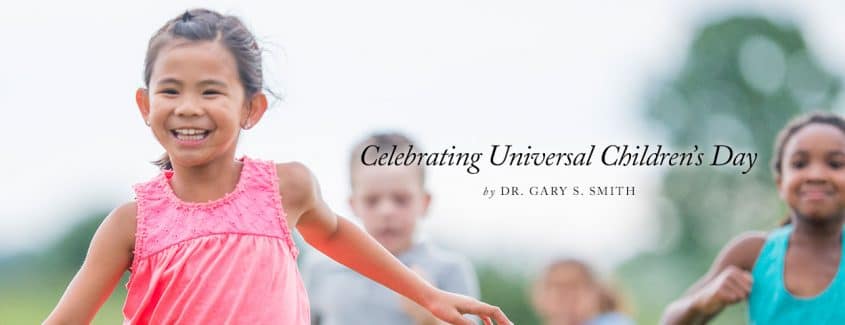
The celebration of United Nations’ Universal Children’s Day on November 20 should prompt us to consider the plight of the world’s children and commit ourselves to working to give them a better life. The UN established this day in 1954 to promote international awareness about the problems children face worldwide and to increase efforts to improve their welfare.
Thankfully, conditions for children are improving. The percentage of the world’s people living in extreme poverty has been cut in half since 1980, freeing many children from the clutches of malnourishment and privation. Today a lower percentage of children are starving to death or dying of disease and a substantially higher percentage of children are attending school than ever before in human history. Deworming occurs throughout most of the world. Four out of five children in even the poorest nations receive some childhood immunizations.
Despite the great progress that has been made, the statistics are still staggering, and many individual stories are heart-breaking. Millions of children still have no access to education, work long hours, often in dangerous conditions for pitifully low wages, and go to bed hungry.
Consider these deplorable facts. According to UNICEF children are about one-third of the world’s population, but they constitute half of all individuals living in acute poverty. UNICEF also estimates that 15 million children are orphans. The International Labour Organization points out that their families’ circumstances compel about 11 percent of children to work, prohibiting them from attending school. The World Health Organization asserts that one out of seven children in less developed nations is underweight. UNICEF reports that more than 250 million children live in countries where armed conflict is occurring. UNHCR, the UN Refugee Agency, estimates that about one-third of the 66 million people around the globe who have been forced to leave their homes are under the age of 18. Every day, WHO declares, 16,000 children under the age of five die.
Save the Children is commemorating Universal Children’s Day by focusing on the theme: “Stop Violence Against Children!” The organization laments, “Children in every country, every culture and at every social level face various forms of abuse, neglect, exploitation and violence.” This abuse occurs in homes, schools, the workplace, and communities. Children suffer because of wars, natural disasters, and sexual abuse, which sadly is still both legal and socially approved in many nations. Children are trafficked, punished in physically and psychologically damaging ways, forced to marry at young ages and to endure genital mutilation, and recruited into street gangs.
The UN asserts in its 1989 Convention on the Rights of the Child that children have “the right to life, to health, to education and to play, as well as the right to family life, to be protected from violence, to not be discriminated, and to have their views heard.” Universal Children’s Day reminds us that many children currently do not enjoy these fundamental rights. Many countries, including the United States, Canada, New Zealand, and the United Kingdom, are holding events on November 20 (or other days) to publicize the problems children face and to work to remedy them. Around the world, schools, health clubs, and child advocacy organizations are sponsoring events to achieve these objectives.
Because of television, the Internet, print media, and the wonderful work of many humanitarian organizations, we all know about the plight of children. We see images or read about the hunger, disease, and squalor that afflicts millions of them around the world. Pictures abound of children sleeping on sidewalks and begging in the streets. We know that in war-torn areas thousands of young boys are forced to serve as soldiers and many young girls are raped.
When we read statistics about the poverty of children around the globe and in America, most of us feel overwhelmed by its magnitude and confused about its causes. Few of us feel responsible to try to help alleviate it. After all, what can one individual do? Trying to aid the hundreds of millions of poor children around the world often seems fruitless, akin to putting a Band-Aid on a gaping wound.

Join us for lunch and a fascinating discussion. Click here to learn how.
But, instead of throwing our arms up in despair, let’s act to help the world’s children. The world has enough resources to provide all children with adequate food to eat and clean water to drink. For $30 billion a year, the FAO estimates, we could abolish world hunger. This amount is less than 2 percent of what the world’s nations collectively spend each year on their military budgets. Providing the additional calories the 13 percent of the world’s chronically hungry people need would require a mere 1 percent of the food we currently produce. Several studies indicate that we could provide clean water to every person in the world for about $20 billion. So, let’s work to channel resources through the public and private sectors to achieve these results.
Those of us who live in wealthy countries can encourage our governments to generously back genuinely positive education initiatives in poorer nations. We should support aid that helps build more schools, that hires and trains more teachers and pays them better, that provides student scholarships, that increases the use of technology in instruction, and that purchases more school supplies. We can urge businesses to use their charitable gifts to underwrite these same ventures, both public and private. We can sponsor more children in developing nations to enable them to attend school rather than be forced to work to support their families.
We can give generously to organizations that are working to alleviate hunger, provide clean water, and educate impoverished children in developing nations. Together we can make a major difference.

